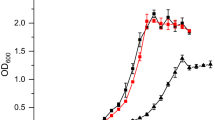Abstract
The facultative chemolithoautotrophic bacterium Cupriavidus necator is known for its ability to store large amounts of polyhydroxyalkanoates (PHA). However, its versatile metabolism, non-pathogenicity, genetic accessibility and productivity have promoted research for numerous value added products beyond PHA. With recent developments in meta - bolic engineering, it has the potential as an alternative production strain for various high value products in biotechnology.
Similar content being viewed by others
Literatur
Schwartz E, Fritsch J, Friedrich B (2013) H2-metabolizing prokaryotes. In: Rosenberg E, De Long EF, Stackebrandt E et al. (Hrsg) The Prokaryotes–Prokaryotic Physiology and Biochemistry. Springer, Berlin, 119–199
Reinecke F, Steinbüchel A (2009) Ralstonia eutropha strain H16 as model organism for PHA metabolism and for biotechnological production of technically interesting biopolymers. J Mol Microbiol Biotechnol 16:91–108
McCarthy A (2003) Metabolix, Inc. and Tepha, Inc.: Bioplastics for industry and medical devices. Chem Biol 10:893–894
Pohlmann A, Fricke WF, Reinecke F et al. (2006) Genome sequence of the bioplastic-producing “Knallgas” bacterium Ralstonia eutropha H16. Nat Biotechnol 24:1257–1262
Nybo SE, Khan NE, Woolston BM et al. (2015) Metabolic engineering in chemolithoautotrophic hosts for the production of fuels and chemicals. Metab Eng 30:105–120
Srivastava S, Urban M, Friedrich B (1982) Mutagenesis of Alcaligenes eutrophus by insertion of the drug-resistance transposon Tn5. Arch Microbiol 131:203–207
Gruber S, Schwab H, Koefinger P (2015) Versatile plasmidbased expression systems for Gram-negative bacteria–General essentials exemplified with the bacterium Ralstonia eutropha H16. New Biotechnol 32:552–558
Voss I, Steinbüchel A (2006) Application of a KDPGaldolase gene-dependent addiction system for enhanced production of cyanophycin in Ralstonia eutropha strain H16. Metab Eng 8:66–78
Lu J, Brigham CJ, Gai CS et al. (2012) Studies on the production of branched-chain alcohols in engineered Ralstonia eutropha. Appl Microbiol Biotechnol 96:283–297
Crépin L, Lombard E, Guillouet SE (2016) Metabolic engineering of Cupriavidus necator for heterotrophic and autotrophic alka(e)ne production. Metab Eng 37:92–101
Chen JS, Colón B, Dusel B et al. (2015) Production of fatty acids in Ralstonia eutropha H16 by engineering ß-oxidation and carbon storage. PeerJ 3:e1468
Volodina E, Raberg M, Steinbüchel A (2015) Engineering the heterotrophic carbon sources utilization range of Ralstonia eutropha H16 for applications in biotechnology. Crit Rev Biotechnol, doi: 10.3109/07388551.2015.1079698
Author information
Authors and Affiliations
Corresponding author
Rights and permissions
About this article
Cite this article
Eggers, J., Hetzler, S. & Steinbüchel, A. Immer (nur) Bioplastik? Cupriavidus necator als Produktionsplattform. Biospektrum 22, 535–537 (2016). https://doi.org/10.1007/s12268-016-0721-0
Published:
Issue Date:
DOI: https://doi.org/10.1007/s12268-016-0721-0



